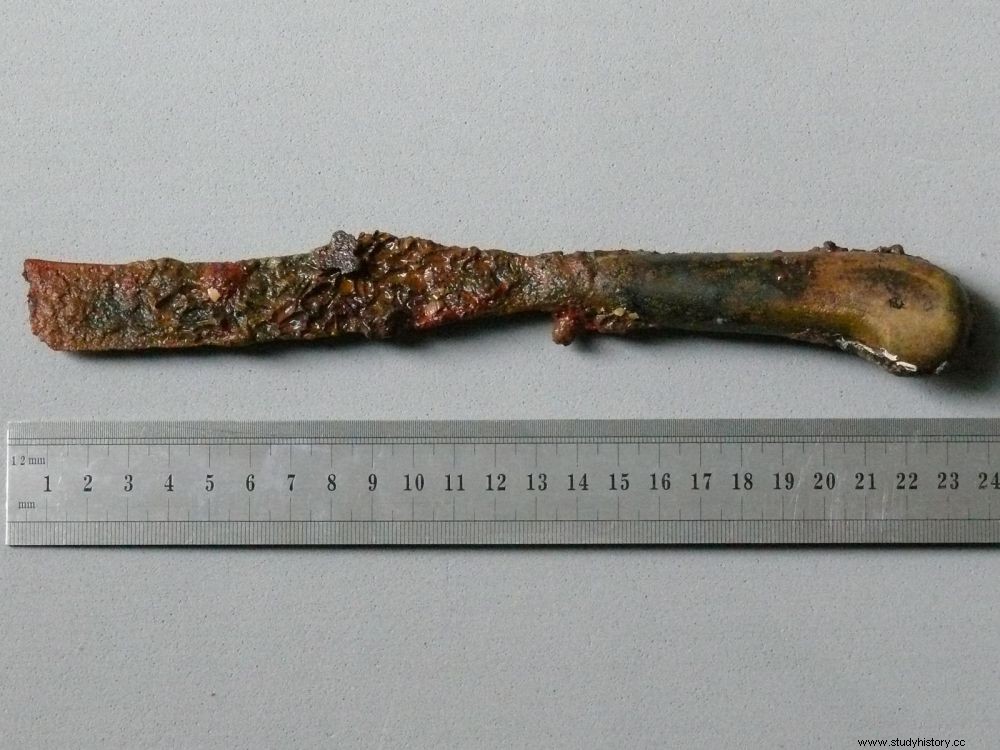Doctor in marine corrosion and expert in conservation-restoration of metals, Jean-Bernard Memet explains how the phenomenon of concretion can imprison the elements of a wreck. Including pirate bones?... Jean-Bernard Memet will be the guest of Sciences et Avenir on Twitch at 5:30 p.m.

The knife of the Jeanne-Elisabeth, an 18th century ship discovered near Palavas-les-flots. This photo illustrates the phenomenon of concretion of the iron blade as well as its "spread" on the horn handle of the knife.
TWITCH. Jean-Bernard Memet is the guest of the Twitch channel of Sciences et Avenir this Thursday, April 15, 2021 for a stream on the theme of underwater wrecks. See you at 5:30 p.m. on twitch.tv/sciencesetavenir.
"Yo-ho-ho! and a bottle of rum!" Fans of pirate stories, you're in for a treat:6 skeletons, including perhaps that of "Black Sam" Bellamy, were found in the wreck of a ship flying the black flag, sunk in 1717. This is at least what was announced by the Whydah Pirate Museum, an establishment established in Cape Cod on the northeast coast of the United States, and bearing the name of the ship of the said pirate discovered in 1984, 6 km from the coast. According to the museum, the bones would have been preserved in "concretions", structures which form in contact with submerged metals. "For there to be concretion there must be masses all around the person. of iron" indeed explains to Sciences et Avenir Michel L'Hour, General Heritage Curator and member of the Scientific and Technical Council (STAB) of UNESCO. Were the pirates we are talking about here, during the sinking, stuck between cannons? Were they dead and already in metal coffins? Even... armor bearers? Impossible for the moment to say. But we wanted to know more about how a metal, underwater, can encompass a body - or an archaeological remains - in a movement that makes it almost "alive" in the words of Jean-Bernard Memet. Expert in the treatment of underwater metals and co-founder of the company A-Corros, currently involved with the DRASSM (Department of underwater and underwater archaeological research), the Laboratory of Archaeological Materials and Weathering Prediction of the CEA of Saclay and the University of Pau and the Pays de l'Adour on the "SOS wreck" program, he answers here questions from Sciences et Avenir .
The Case of the Hunley Submarine
Sciences et Avenir:Is it common to find skeletons in shipwrecks?
Jean-Bernard Memet:No. It is even extremely rare. It happened on "La Boussole", one of the two wrecks of La Pérouse's boats discovered in Vanikoro off the coast of the Solomon Islands. On the Vasa which sank as soon as it was launched in 1648 in Stockholm where a sailor got stuck between two cannons. Or the Hunley submarine, found off Charleston, South Carolina. An emblematic case of the conditions necessary for an entire skeleton to be found. The Hunley is the first submarine in human history that sank a ship - that was in 1848 - and sank itself on its way back. There were found the 8 bodies of the crew members who, in the closed environment of the submarine, had remained locked up there.
Otherwise, a body is fatally dismantled and does not remain at the wreckage site?
Absolutely. A submerged corpse will first see its tissues soften and then putrefy. This is followed by a release of gas, then a rupture of the tendons and the bones are evacuated by the sandstone of the sea currents, and the intervention of opportunistic animals. So without confinement, the bones are necessarily scattered. Thus, in Vanikoro, if we found 80% of the skeleton of a sailor from La Pérouse on one of the wrecks, it is because he was locked in a cabin at the time of the sinking.
PODCAST. Find out about this subject in the France Culture program "La Méthode scientifique" of February 19, 2021 with Olivier Lascar, editor-in-chief of the digital division of Sciences et Avenir - La Recherche.
Bones in the Vasa warship
Let's imagine that the corpse of the pirate was wedged between two cast iron cannons. How can this structure turn into a sort of cage?
To understand this, it must be remembered that not all metals - apart from gold - exist in pure form in nature. But in the form of minerals. And a metal spontaneously returns to the state of ore when it is brought into contact with a corrosive agent, the oxygen contained in water for example. It's an immediate phenomenon, it starts the second after sinking! And at the same time as this electrochemical phenomenon starts, a biological process begins, with the appearance of a first bacterial colony. Then several colonies forming a biofilm on the surface of the metal within 10 minutes of immersion. The biofilm conditions the surface so that it can accommodate the entire food chain, microalgae and macroalgae, those that can be seen with the naked eye. Among these, there are a number that are able to synthesize, agglomerate calcium and magnesium from water and this initiates the phenomenon of mineral concretion. Over time, concretion, corrosion of the metal and living environment form a solid and dense gangue, which will potentially trap and protect an object near the metal. In the case of bones stuck between guns, it is therefore very rare, but it has already been seen:in the wreck of the Vasa, an old warship now on display in Stockholm, we have thus found a body that had been caught in this metal trap.
Note that Jean-Bernard Memet is also co-author of the show "Faire fer", with Philippe de Viviés (A-Corros) and Alexandre Denis (La Mondiale Générale), circus artist, a show that tells the magic of transformation ore into metal and the metal's urge to return to its ore state. Premiere on April 23, 2021 at the Musée départemental de l'Arles Antique, subject to reopening.
